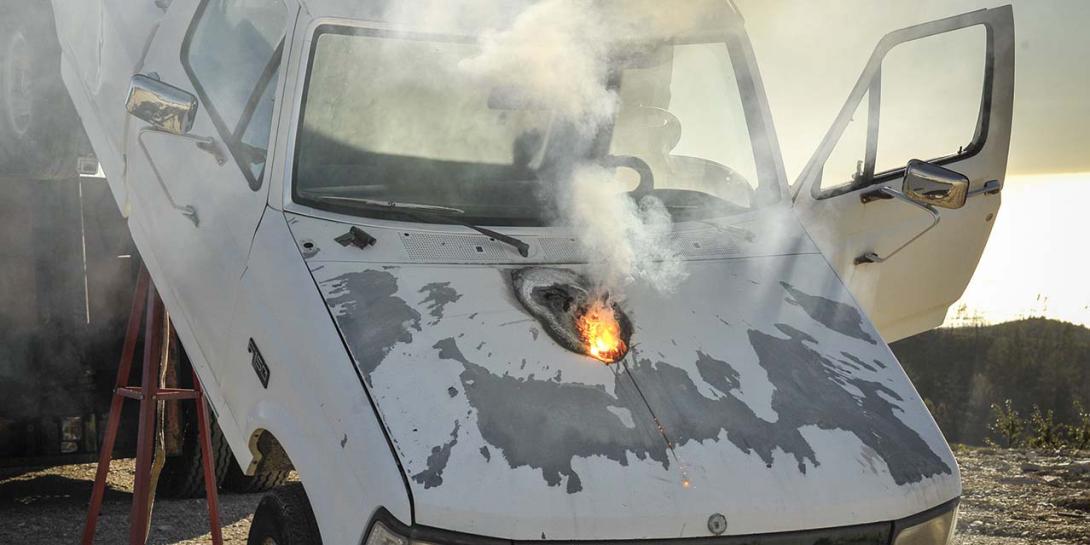Fielding Laser Weapons Is Only a Matter of Desire
Each of the U.S. military services and the Special Operations Command plan to field laser weapons in the coming years. But Lockheed Martin officials say they could deliver now a 30-kilowatt weapon system—powerful enough to bore a hole in a steel plate within seconds—if the military asks.
Laser weapons will be integrated onto land, air and maritime platforms and offer long-distance precision, an unlimited and inexpensive firing capability and low collateral damage. They can counter rockets, artillery and mortars, and land, sea and air vehicles, including small drones. They also can be adjusted to cause varying degrees of damage, from blinding a surveillance camera to shooting a plane from the sky or destroying a truck engine.
While briefing reporters at Lockheed Martin’s March 15 media day in Arlington, Virginia, Robert Afzal, a senior fellow with Lockheed Martin Laser and Sensor Systems, and others agreed the weaponry is ready now. “Everything exists today. It’s just a question of the desire,” Afzal said. “The irony of why we don’t have laser weapon systems today is that we never actually had a laser small enough, powerful enough to be put in a tactical platform. What’s changed now ... is that the last piece of the puzzle is here.”
Lockheed officials say lasers will complement rather than replace conventional kinetic weaponry. Kinetic systems offer clear capabilities lasers cannot supplant. “But the lasers can provide additional capabilities. They can provide new capabilities. And they can provide scalable effects that kinetic systems can’t,” Afzal said.
Lasers will need to prove they deserve to take up space on planes, ships and ground vehicles. “The laser weapon system is going to have to buy its way onto a platform. It’s going to have to prove it’s effective. No commander is going to want to get rid of all their guns and rely on lasers, initially,” said Paul Shattuck, director, directed energy systems, Lockheed Martin Space Systems.
Integrating lasers onto aerial platforms is more problematic because of the air dynamics around the aircraft. Still, the technology is at a “tipping point,” reported Daniel Miller, senior fellow, air vehicle science and systems, Lockheed Martin Skunk Works. “We at Skunk Works are ready to take this technology, capitalize on it, integrate it into air platforms and go demonstrate it to the customers. I think we are ready to do that in the near future.” Lockheed is working on that problem through a Defense Advanced Research Projects Agency effort known as the Aero-Adaptive, Aero-Optic Beam Control (ABC) program. The program is intended to develop airborne laser technology capable of shooting 360 degrees.
Afzal explained the science behind laser weapons. When white light hits a prism, the prism breaks it down into individual colors of the rainbow, he said. “That basic physics you can also employ for combining high-powered lasers. We take fiber lasers, each of a slightly different color, send them back through the ‘prism,’ and if you have the right color at the right wavelength, all the beams will line up on top of each other and a single, high-powered beam will come out,” Afzal elaborated.
Laser technology has matured in part because of video game technology. “The processing capabilities that came with those video games allow us to employ advanced algorithms for identifying targets at longer range, Shattuck said.
The Lockheed team showed reporters a quadcopter drone and a drone video camera, both of which had been taken out by a 30-kilowatt laser known as Advanced Test High-Energy Asset (ATHENA), which defeated four quadcopter drones in a demonstration last year. The system burned the camera itself in one case; in another, it targeted the electronics for one of the four rotors, sending the entire drone plummeting to the ground. The company also exhibited a steel plate roughly two inches thick that the laser weapon had burned a whole into in a matter of seconds.





Comments